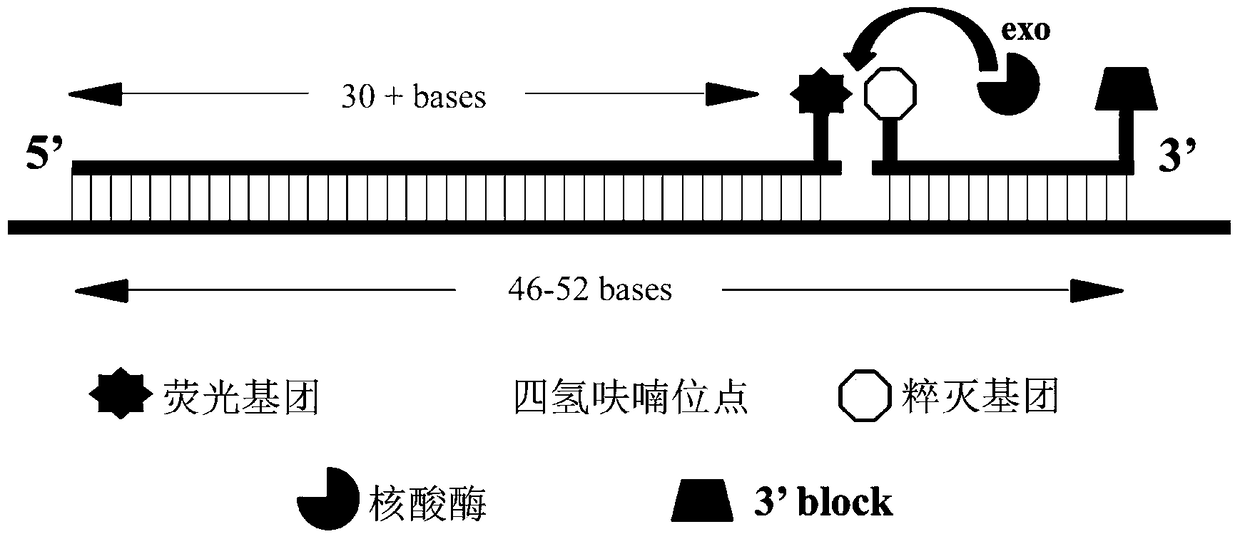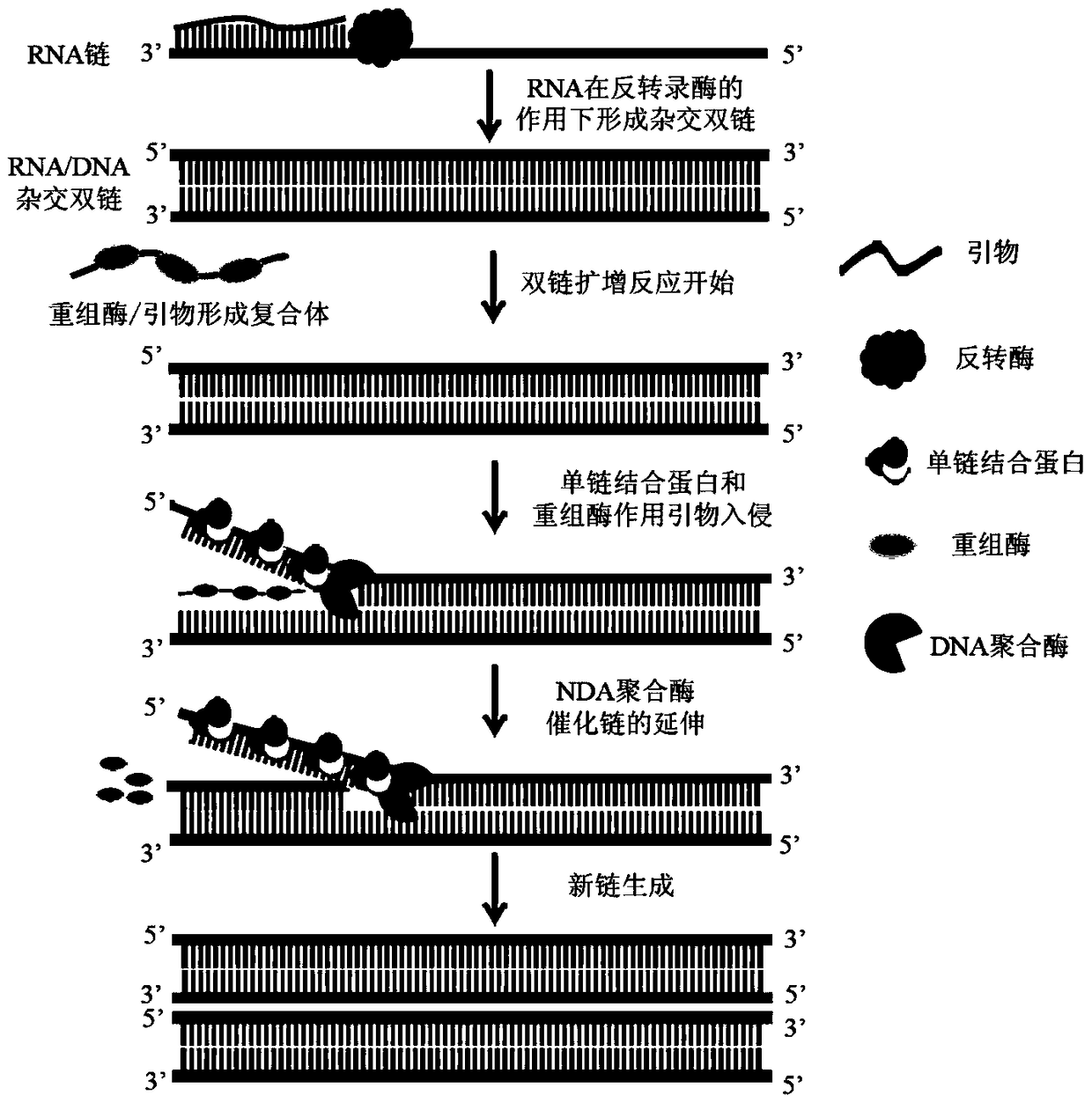Method, reagent, primers and probes for isothermal rapid detection of Ebola virus at room temperature
An Ebola virus, normal temperature and isothermal technology, applied in biochemical equipment and methods, microbial measurement/inspection, DNA/RNA fragments, etc., can solve problems such as undiscovered reports, achieve portable operation, and prevent false positives Simple effect of interference, detection operation requirements
- Summary
- Abstract
- Description
- Claims
- Application Information
AI Technical Summary
Problems solved by technology
Method used
Image
Examples
Embodiment 1
[0046] Embodiment 1: Screening of primers
[0047]With reference to 20 EBOV NP gene sequences published on GenBank, the inventors of the present application have carried out a more in-depth study on the information such as the genome, protein structure and function of the NP of EBOV, and the content of the NP gene in EBOV is higher, the present invention The NP gene of EBOV was selected as the target gene. A large number of experiments show that different primers have certain influence on the effect and sensitivity of isothermal amplification. Therefore, in this study, three pairs of different primers were initially designed for the NP gene of EBOV-Z subtype: NP-1, NP-2 and NP-3 (as shown in Table 1), these sequences can be combined with EBOV-S subtype The corresponding sequence of the NP gene specifically binds.
[0048] Table 1: Sequences of primers and probes
[0049]
[0050] image 3 It is the electrophoresis pattern of the effect of primers on the amplification ef...
Embodiment 2
[0055] Example 2: Fluorescence reverse transcription RAA detection
[0056] This example is used to illustrate the fluorescent reaction at room temperature and constant temperature on the Twista instrument.
[0057] 1. According to the NP gene sequence of Ebola-Zaire virus (EBOV-Z) that has been published on NCBI GenBank, the NP gene of Ebola-Zaire virus has been fully synthesized.
[0058] 2. Based on the design principles of primers and fluorescent probes, a pair of primers (NP-3-F and NP-3-R) and a fluorescent probe (NP-Probe) were designed according to the NP gene sequence of Ebola virus. As shown in table 2:
[0059] Table 2 Sequences of primers and probes of Ebola virus NP gene
[0060]
[0061] *(F) is a fluorescent group (Fluorophore), (H) is a tetrahydrofuran residue (THF residue), (B) is a quenching group (Quencher), and the 3' end is modified by Spacer C3 (Biotin-TEG).
[0062] 3. The components of the lyophilized powder reaction unit are:
[0063] Table 3 Co...
Embodiment 3
[0070] Example 3: Fluorescence reverse transcription RAA detection of influenza A virus
[0071] This example is used to illustrate the feasibility of fluorescent reverse transcription RAA to detect actual samples.
[0072] 1. According to the gene sequence of influenza A virus matrix protein that has been published on NCBI GenBank, perform sequence homology analysis to find a gene sequence with high homology, as shown below:
[0073] 5’-ATGAGTCTTCTAACCGAGGTCGAAACGTATGTTCTCTCTATCGTTCCGTCAGGCCCCCTCAAAGCCGAGATAGCGCAGAGACTTGAAGATGTTTTTGCAGGGAAAAACACCGATCTTGAGGCACTCATGGAATGGCTAAAGACAAGACCAATCCTGTCACCTCTGACTAAGGGGATTTTAGGATTTGTTGTTCACGCTCACCGTGCCCAGTGAGCGAGGACTGCAGCGTAGACGCTTTGTCCAGAAAGCCCTCAATG’
[0074] 2. Based on the principle of primer and fluorescent probe design, a pair of primers (FluA-M-F and FluA-M-R) and a fluorescent probe (FluA-M-Probe) were designed according to the conserved sequence of the above-mentioned influenza A virus matrix protein. As shown in Table 5:
[0...
PUM
| Property | Measurement | Unit |
|---|---|---|
| Sensitivity | aaaaa | aaaaa |
Abstract
Description
Claims
Application Information
 Login to View More
Login to View More - R&D
- Intellectual Property
- Life Sciences
- Materials
- Tech Scout
- Unparalleled Data Quality
- Higher Quality Content
- 60% Fewer Hallucinations
Browse by: Latest US Patents, China's latest patents, Technical Efficacy Thesaurus, Application Domain, Technology Topic, Popular Technical Reports.
© 2025 PatSnap. All rights reserved.Legal|Privacy policy|Modern Slavery Act Transparency Statement|Sitemap|About US| Contact US: help@patsnap.com



